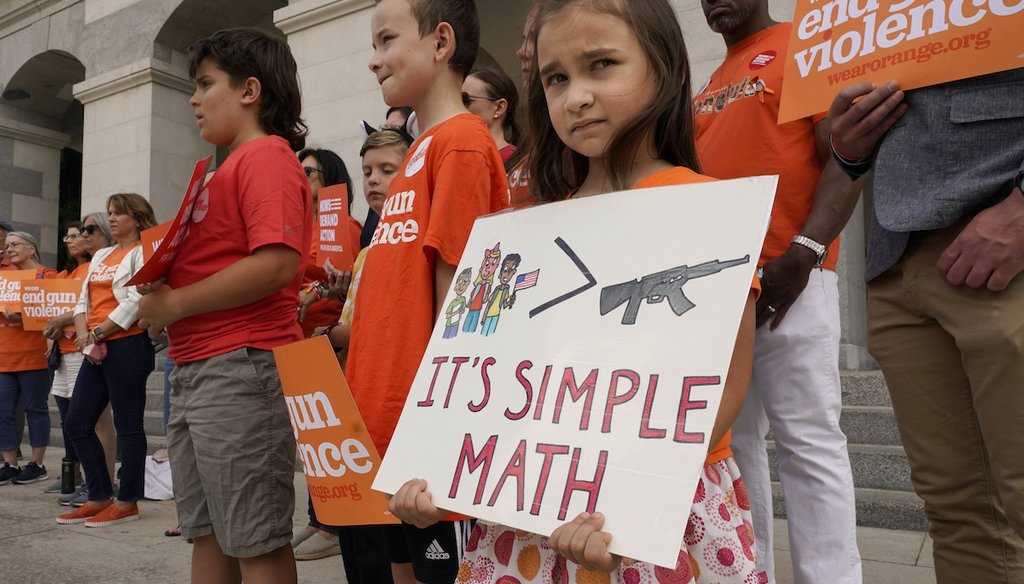Get PolitiFact in your inbox.

Elise Schering, 7, displays a message during a National Gun Violence Awareness rally at the Capitol in Sacramento, Calif., June 2, 2022. Gov. Gavin Newsom announced that California is spending $11 million to promote use of red flag laws. (AP)
If Your Time is short
-
"Red flag” laws allow law enforcement or family members to petition courts to temporarily remove firearms from individuals if they pose a danger to themselves or others.
-
Courts can issue emergency orders that remove the person’s weapons for up to three weeks. Final orders, which include the opportunity for the person to defend themselves at a hearing, often last up to a year.
-
Nineteen states and Washington, D.C. have red flag laws. Previous efforts to pass a nationwide red flag law have stalled in Congress. But recent mass shootings have prompted bipartisan negotiations in the Senate that could include some type of legislation to expand red flag laws.
Democratic and Republican senators may find rare consensus on gun legislation by supporting the expansion of red flag laws. These laws allow courts to temporarily take away a gun from someone who shows signs of a threat.
In Texas, more than 250 conservatives who identify as gun enthusiasts wrote a letter to Sen. John Cornyn, R-Texas, in support of restrictions, including red flag laws.
"We believe in the Second Amendment. Like many, we are struggling for good answers to our current problem of gun violence in America," they wrote in a letter published as a full page ad in the Dallas Morning News.
Cornyn is one of the senators negotiating with Democrats to provide federal grants to encourage states to pass red flag laws. Here’s how they work.
What are red flag gun laws?
These laws are meant to remove weapons from dangerous people before a crime or tragedy occurs — hence the phrase "red flag."
The process allows people to petition a civil court to temporarily remove that person’s firearms. Red flag laws are sometimes called extreme risk protection orders (shorthanded as ERPOs); gun violence restraining orders; or state crisis intervention orders.
The mass shooter at Marjory Stoneman Douglas High School in Parkland, Florida, for example, was the subject of two tips to the FBI about his plans and multiple 911 calls about his behavior for years before the shooting.
Each state’s law sets rules for who can start the petition process. Some states only allow law enforcement to request the orders. Other states allow family members or close contacts, such as coworkers or teachers, to file a petition. Most petitions are filed by law enforcement, and they are usually granted by the courts.
The petitions generally ask for some sort of documentation. For example, petitioners in Maryland are asked to write on a form what behaviors lead them to believe the person poses an immediate danger by possessing a firearm. It also asks the petitioner to list the number, type and location of the individual’s guns and the individual’s past acts or threats of violence, substance abuse and criminal history.
Once the court receives a petition, judges must follow their state law that explains what criteria a judge must or could consider.
In California, judges must consider whether the person has made threats, acted violently within the past six months or had a pattern of threats or violence over the past year. They must consider whether the person has violated a domestic violence emergency protective order or was convicted of a crime that would keep from legally keeping a firearm. A judge can consider evidence of alcohol or substance abuse.
If the threat of harm is imminent, courts can issue an emergency order without a hearing ordering the removal of a person’s guns. But those orders last only from a few days to three weeks. Before issuing a final order, a court holds a hearing where the person can testify on their own behalf or bring a lawyer.
In most states, final orders can last up to a year, though they can be extended. Once the order is issued, the individual must surrender their firearms. For example, Colorado’s law says that individuals can either sell their firearms to a federally licensed dealer or arrange for storage by a law enforcement agency. If the individual owns an antique firearm, it can be transferred to an eligible relative who doesn’t live with them.
In Broward County, Florida, Chief Judge Jack Tuter said around half of the individuals agree to the order because they don’t own a gun, and many others agree to turn over their firearm.
"In a very small or insignificant portion of the cases the person actually fights the risk protection order and comes to court, and sometimes they win and sometimes lose," Tuter said.
Critics of red flag laws say they lack due process, but that’s not accurate. These are civil proceedings where individuals can testify and face no risk of incarceration, Palm Beach State Attorney Dave Aronberg said. Prosecutors are involved only if someone violates an order, which is rare, Aronberg said.
It is possible for someone who is undergoing the red flag law to separately face a criminal charge. But in many situations there is no parallel criminal case.
Courts in Connecticut, Indiana and Florida ruled that the laws do not violate the process rights of respondents or are constitutional.
Which states have red flag gun laws?
Connecticut was the first state to pass a red flag law in 1999. It followed a mass shooting by an accountant who worked for the state lottery. In the month leading up to the attack, the shooter showed clear signs that he was troubled.
Many other states have passed similar laws, including seven passed by Republican governors. States with red flag laws today include California, Colorado, Connecticut, Delaware, Florida, Hawaii, Illinois, Indiana, Maryland, Massachusetts, Nevada, New Jersey, New Mexico, New York, Oregon, Rhode Island, Vermont, Virginia and Washington as well as the District of Columbia.
Florida passed its red flag law in 2018 after the Parkland school shooting. Since then, Florida courts have issued about 8,000 final orders, according to data compiled by the Office of the State Court Administrator.
RELATED: Training for journalists from the Poynter Institute on how to cover the gun debate
What type of red flag law legislation is the Senate considering?
Bills in Congress to create a national red flag law have stalled. But senators from both parties are negotiating legislation that would give grants to states to pass or administer their own red flag laws.
Sen. Pat Toomey, R-Pa., said June 5 that he hopes to gain support from more than 10 Republicans in the Senate, the threshold required to pass such legislation.
"Encouraging states to have some kind of red flag laws could make sense as long as there's adequate due process," Toomey said, adding that senators could also address school safety and mental health. "So there are things we could do that would be constructive, that are consistent with Republican values, and I'm hoping we'll get there."
But some Republicans have opposed the idea of any type of federal red flag incentive, saying that it should be left up to the states.
Sen. Chris Murphy, D-Conn., recently described the effort to pass the legislation as "a test of democracy. It's a test of the federal government as to whether we can deliver at a moment of just fierce anxiety amongst the American public."
Do red flag laws work?
It’s challenging for researchers to determine whether mass shootings are prevented by red flag laws.
The Violence Prevention Research Program at University of California, Davis studied 200 cases in California between 2016 and 2018. An in-depth analysis of 21 mass shooting threats found that none of them occurred after a red flag law was used.
"While it is impossible to know what would have happened without the intervening (extreme risk protection orders), these are promising results," researchers wrote.
There is stronger evidence that red flag laws prevent suicides.
Studies of laws in Connecticut and Indiana found that one suicide is prevented for every 10 to 20 orders issued. But findings of population-level studies are mixed, the Violence Prevention Research Program found.
There are limits to the powers of red flag laws. Most notably, they don’t necessarily lead to mental health treatment. Tuter said he can order someone to have a mental health evaluation, but if that process turns up a diagnosis, the law does not allow a judge to order treatment. And even those who want treatment may lack access to mental health care.
"The state and counties need to wake up and start funding mental health programs," Tuter said.
Violence prevention experts say red flag laws are one of many strategies that could reduce access to firearms for individuals who pose a threat.
Extreme risk protection orders "are one important law in that network," said Veronica Pear, an assistant professor in the UC Davis program. "But there are other laws that are supported by evidence as well, such as prohibiting the purchase and possession of firearms after a violent misdemeanor conviction, waiting periods, and firearm licensing laws."
Experts on red flag laws warn they are only as good as their implementation. Illinois state Rep. Denyse Stoneback said the Firearms Restraining Order Act, passed in 2018, hasn’t been used much in her state, which she attributed to a lack of knowledge from both officers and the public. To address that, Stoneback sponsored a bill to support a $1 million education campaign for police. It became law but did not go into effect until June 1, so its impact isn’t clear.
"It's another tool in the toolbox to reduce violence when someone's exhibiting dangerous behavior," Stonebeck said. "But it can only really be effective if it's utilized."
Staff writer Hana Stepnick contributed to this article.
RELATED: Polls consistently show high support for gun background checks
RELATED: Fact-checking misinformation about the Uvalde school shooting
RELATED: All of our fact-checks about guns
Our Sources
Violence Prevention Research Program at UC Davis memo, Extreme Risk Protection Orders to prevent mass shootings: What do researchers know? June 2022
Brady, What are extreme risk laws? Accessed June 7, 2022
Giffords Law Center to Prevent Gun Violence, Extreme risk protection orders, Accessed June 7, 2022
WFAA, Letter in Dallas Morning News calls for gun reform after recent mass shooting, June 6, 2022
New York Times, Rampage in Connecticut: The overview; Connecticut Lottery worker kills 4 Bosses, then himself, March 7, 1998
Congress.gov, H.R.2377 - Federal Extreme Risk Protection Order Act of 2021, Introduced April 8, 2021
CNN State of the Union, Transcript, June 5, 2022
CBS Face the Nation, Toomey says expanding gun background checks "on the table" as Senate talks continue, June 5, 2022
UC Davis, California’s ‘red flag’ law utilized for 58 threatened mass shootings, June 7, 2022
Law and Contemporary Problems, Implementation and effectiveness of Connecticut’s risk-based gun removal law: does it prevent suicides? 2017
Journal of the Academy of Psychiatric Law, Criminal justice and suicide outcomes with Indiana's risk-based gun seizure law, April 15, 2019
Washington Post, Some in GOP question red-flag laws as Senate tries to clinch gun deal, June 9, 2022
Maryland, Petition for extreme risk protection order
Colorado, Extreme risk protection order law, 2019
Florida Office of state Court Administrator, Extreme risk protection orders data, March 2018 to March 2022.
PolitiFact, No, Rubio’s ‘red-flag’ bill would not allow gun confiscation without due process, March 4, 2021
PolitiFact, How Florida’s red flag gun law works, Aug. 26, 2019
PolitiFact Virginia, Ralph Northam is right: GOP governors and legislatures have OK'd 'red-flag' gun laws, Jan. 23, 2019
Email interview,Veronica Pear, Assistant Professor in Residence in the Violence Prevention Research Program in the Department of Emergency Medicine University of California, Davis, June 7, 2022
Telephone interview, Jack Tuter, Broward chief judge, June 6, 2022
Telephone interview, David Aronberg, Palm Beach state attorney, June 7, 2022
Ilga.gov, H.B. 1092, Enrolled August 13, 2021
Ilga.gov, Firearms Restraining Order Act, Effective January 1, 2019
Ilga.gov, H.B. 0900, p. 542, Sec. 132, Enrolled April 19, 2022
Telephone interview, Denyse Stoneback, Illinois state representative, June 9, 2022
Illinois Criminal Justice Information Authority, Firearm Restraining Orders in Illinois, March 11, 2022












































